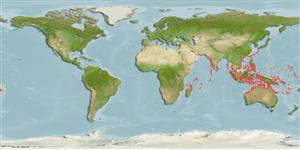>
Gobiiformes (Gobies) >
Gobiidae (Gobies) > Gobiinae
Etymology: Trimma: Greek, trimma, -atos = something crushed (Ref. 45335).
Eponymy: Dr Stefan Meiring Naudé (1904–1985) was a South African physicist who was Professor of Physics at Stellenbosch University (1934–1946). [...] (Ref. 128868), visit book page.
More on author: Smith.
Environment: milieu / climate zone / depth range / distribution range
ນິເວດວິທະຍາ
ສັດທະເລ ກ່ຽວກັນຫີນ; ລະດັບຄວາມເລິກ 3 - 30 m (Ref. 1602), usually 3 - 30 m (Ref. 27115). Tropical; 22°C - 26°C (Ref. 27115); 30°N - 22°S
Indo-West Pacific: Seychelles, Aldabra, Chagos Islands, Ryukyu Islands, and Loyalty Islands; Mariana and Marshall islands in Micronesia.
ຂະໜາດ / ນ້ຳໜັກ / Age
Maturity: Lm ? range ? - ? cm
Max length : 3.5 cm SL ຕົວຜູ້/ບໍ່ມີເພດ; (Ref. 48637)
ຄີ (ໜາມ)ແຂງຢູ່ຫຼັງປາ (ທັງໝົດ) : 7; ຄີຫຼັງຂອງປາ (ຄີອ່ອນ) (ທັງໝົດ) : 7 - 8; ຄີ(ໜາມ) ແຂງຢູ່ຄີກົ້ນປາ
ກຸ່ມປາກະດູກແຂງ
ຄວາມຖີ່ຂອງກຸ່ມຖ່າຍທອດພັນ
ປາທີ່ມີການເຄື່ອນຍ້າຍຈາກທະເລໄປຫານ້ຳຈືດ ແລະນ້ຳຈືດຫາທະເລ
ປາທີ່ມີການເຄື່ອນຍ້າຍຈາກທະເລແລະໄປໄຂ່ຢູ່ນ້ຳຈືດ
ຄີກົ້ນຂອງປາ
ສັດທີ່ມີກະດູກສັນຫັຼງ
ການຖ່າຍທອດທາງກຳມະພັນຈາກພໍ່ແມ່ຫາລູກ: 1; ຄີກົ້ນຂອງປາ: 7 - 9. Diagnosis: a frontal ridge behind the orbits that slopes steeply into a wide interorbital trench
anteromedially, and into postorbital trenches laterally; posterior nasal opening separate from eye; second spine of first dorsal fin elongate, third spine occasionally elongate; fifth pelvic fin ray branched once dichotomously; body color orange-red with seven dorsolateral white spots
between posterodorsal margin of the peduncle and origin of first dorsal, and with four ventrolateral spots between posteroventral margin of peduncle and origin of last anal ray; facial pattern uniform dusky orange-grey colour under orbit, with an orange vertical blotch, edged in melanophores on vertical limb of the preopercle resembling a club; conspicuous bar of melanophores extending vertically across posterior margin of pectoral base (Ref. 57688).
Occurs in lagoons and seaward reefs; on rubble and reef rock (Ref. 1602); also over coral patches interspaced with fine sandy bottoms, occasionally form small schools (Ref. 37688). Feeds on copepods, ostracods, and radiolarians (Ref. 1602).
Life cycle and mating behavior
ການຈະເລີນເຕັມໄວ | ການສືບພັນ | ການວາງໄຂ່ | ໄຂ່ | ຄວາມດົກຂອງໄຂ່ປາ | ຕົວອ່ອນ
Myers, R.F., 1991. Micronesian reef fishes. Second Ed. Coral Graphics, Barrigada, Guam. 298 p. (Ref. 1602)
IUCN Red List Status (Ref. 130435: Version 2024-2)
Threat to humans
Harmless
Human uses
ການປະມົງ: ເປັນສີນຄ້າ; ຕູ້ປາ: ເປັນສີນຄ້າ
ເຄື່ອງມື
Special reports
Download XML
ແຫຼ່ງອີນເຕີເນັດ
Estimates based on models
Preferred temperature (Ref.
123201): 25.3 - 29, mean 28 °C (based on 1090 cells).
Phylogenetic diversity index (Ref.
82804): PD
50 = 0.5000 [Uniqueness, from 0.5 = low to 2.0 = high].
Bayesian length-weight: a=0.01023 (0.00477 - 0.02194), b=3.01 (2.83 - 3.19), in cm total length, based on LWR estimates for this (Sub)family-body shape (Ref.
93245).
ຊັ້ນເຂດຮ້ອນ (Ref.
69278): 3.3 ±0.42 se; based on food items.
ຄວາມຢືດຢຸ່ນ (Ref.
120179): ສູງ, ປະຊາກອນຕຳ່ສຸດທີ່ໃຊ້ເວລາສອງໜ້ອຍກວ່າ 15 ເດືອນ (Preliminary K or Fecundity.).
Fishing Vulnerability (Ref.
59153): Low vulnerability (10 of 100).
Nutrients (Ref.
124155): Calcium = 263 [124, 654] mg/100g; Iron = 1.28 [0.61, 2.50] mg/100g; Protein = 18.3 [16.3, 20.0] %; Omega3 = 0.174 [0.069, 0.381] g/100g; Selenium = 24.6 [10.2, 55.9] μg/100g; VitaminA = 147 [39, 539] μg/100g; Zinc = 3.11 [1.90, 4.84] mg/100g (wet weight);
